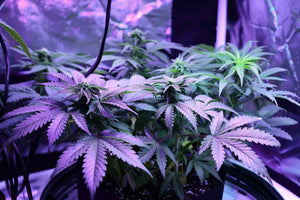When it comes to indoor gardening, most growers focus on the basics: adequate water, proper nutrients, and sufficient light. However, there's one crucial element that many overlook—UV light for plants.
While traditional grow lights provide the essential red and blue wavelengths for photosynthesis, but UV light plays a vital role in your plants' healthy growth.
Let’s explore why UV light for plants is so important.
Why Do Plants Need UV Light?
Before diving into why your plants need UV radiation, it's essential to understand what UV light actually is. Ultraviolet light exists beyond the visible spectrum, with wavelengths shorter than violet light but longer than X-rays. For plant cultivation, we focus on three main types:
UVA (320-400 nm): UVA boosts photosynthesis in plants. For example, it helps tomato leaves produce sugar faster, promoting fruit growth.
UVB(280-320 nm): UVB stimulates plants to produce more antioxidants and secondary metabolites (such as cannabinoids or anthocyanins), which enhance disease resistance.
UVC(100-280 nm): UVC is generally considered harmful to plants and is primarily used for sterilization purposes rather than cultivation. Most uv lights for growing avoid this wavelength entirely.
So, let’s focus on UVA and UVB.
Benefits of UV Light
Using uv lamp plantsnot only improves plant quality but also increases yield. Let's take a look.
1.Improves Plant Quality

A study by C. Jenkins and his team in _Frontiers in Plant Science_ found that under UVB light, cannabis produces secondary metabolites faster.
This boosts THC and CBD levels, leading to bigger buds, richer effects, and enhanced flavor.
On the other hand, crops like tomatoes and strawberries focus more on flavor. UV light helps enhance their aroma and taste.
Comparison table of UVB wavelength and secondary metabolite synthesis efficiency:
| Wavelength Range (nm) | THC Yield Increase (%) | Experimental Conditions | Data Source |
|---|---|---|---|
| 280-300 | 18.7 ± 2.3 | 2 hours/day exposure | HLG 2024 Report |
| 300-320 | 22.5 ± 1.8 | 3.2 μmol/m²/s | DLC Certified Lab |
2.Boosts Disease Resistance
UV light helps plants fight pathogens and pests.
UVB exposure triggers plants' defense mechanisms. Once exposed to UV light, plants immediately produce protective proteins that inhibit bacterial and fungal invasions.
Research by Y. Takahashi's team showed that cucumbers produce more defense proteins under UV light, improving their resistance to fungal infections.
3.Enhances Yield and Structure

ultraviolet lamp for plants not only improves quality but also optimizes yield and structure.
Studies show UV-B reduces internode length in grapes, resulting in better yield and appearance. The fruits become denser, with thicker skins and higher harvest weight.
Without UV light, grape plants appear weak, and their fruit density is lower.
How to Provide UV Light Safely?
uv lamp plants offers many benefits, but excessive exposure can harm plants.
Just as human skin gets sunburned from too much sunlight, plant leaves and stems can get scorched by strong UV rays.
When using uv light for plants monitor the duration and distance from the plants.
1.Choose the Right Lamp
Many uv lamp plants are available, focusing on UVA and UVB spectra. Some growers prefer dedicated uv lamp for plants that can be added to existing lighting systems for targeted UV exposure.
Avoid using UV-C sterilization or beauty lamps, as they can harm plants.
2.Control Exposure Time
Most plants need only 2-4 hours of uv lamp plants per day for growth.
Exposing plants too long can cause strong light reactions, like leaf burn.
A timer helps control exposure and prevent accidental overexposure.
3.Maintain Proper Lamp Distance
Keep the lamp 30-50 cm from the plants.
Too close may concentrate ultraviolet light and harm the plants. Too far may reduce effectiveness.
Adjust the lamp height and position based on plant type and growth stage.
Recommended UV Light
TheOneGrow offers 60W and 120W UV lights, compatible with 640W , 800W, 1000W,1200W and 1600W led grow lights.

1. Professional Spectrum: 365nm UV + 730nm IR spectrum, designed for flowering stages.
2. Improves Flavor and Quality: Increases terpene content, enhances flavor, and boosts THC by 20-25%.
3. Flexible Use: Can be combined with LED grow lights.
FAQ
Q1:Can I use a regular UV bulb for plants?
A: No! Household UV bulbs (like nail lamps) emit UVC or uneven wavelengths. Always use horticulture-specific UV grow lights.
You should choose UV grow lights that focus on the UVA and UVB spectra. Avoid using UV - C sterilization or beauty lamps as they can harm your plants.
Q2: How long should I expose my plants to uv lamp for plants each day?
A: Most plants need only 2 - 4 hours of UV light per day for growth. Using a timer can help you control the exposure time and prevent overexposure,and allow your plants to grow more healthily.
Q3: What if the UV lamp is too close to my plants?
A: If the lamp is too close, the UV light can be concentrated, which may scorch the plant leaves and stems. It's best to keep the lamp 30 - 50 cm from the plants and adjust the height based on the plant type and growth stage.
Q4: Can UV light really improve the flavor of my crops?
A: Yes, it can. UV light helps enhance the aroma and taste of crops like tomatoes and strawberries. In cannabis plants, it can also increase THC and CBD levels, improving the overall quality and flavor.
Conclusion
When growing cannabis or other plants, don’t underestimate the role of UV light alongside water, nutrients, regular lighting, ventilation, and temperature and humidity control. UV light can further enhance cannabis quality and flavor.
Remember to maintain the right distance and exposure time when using uv light for plants.

